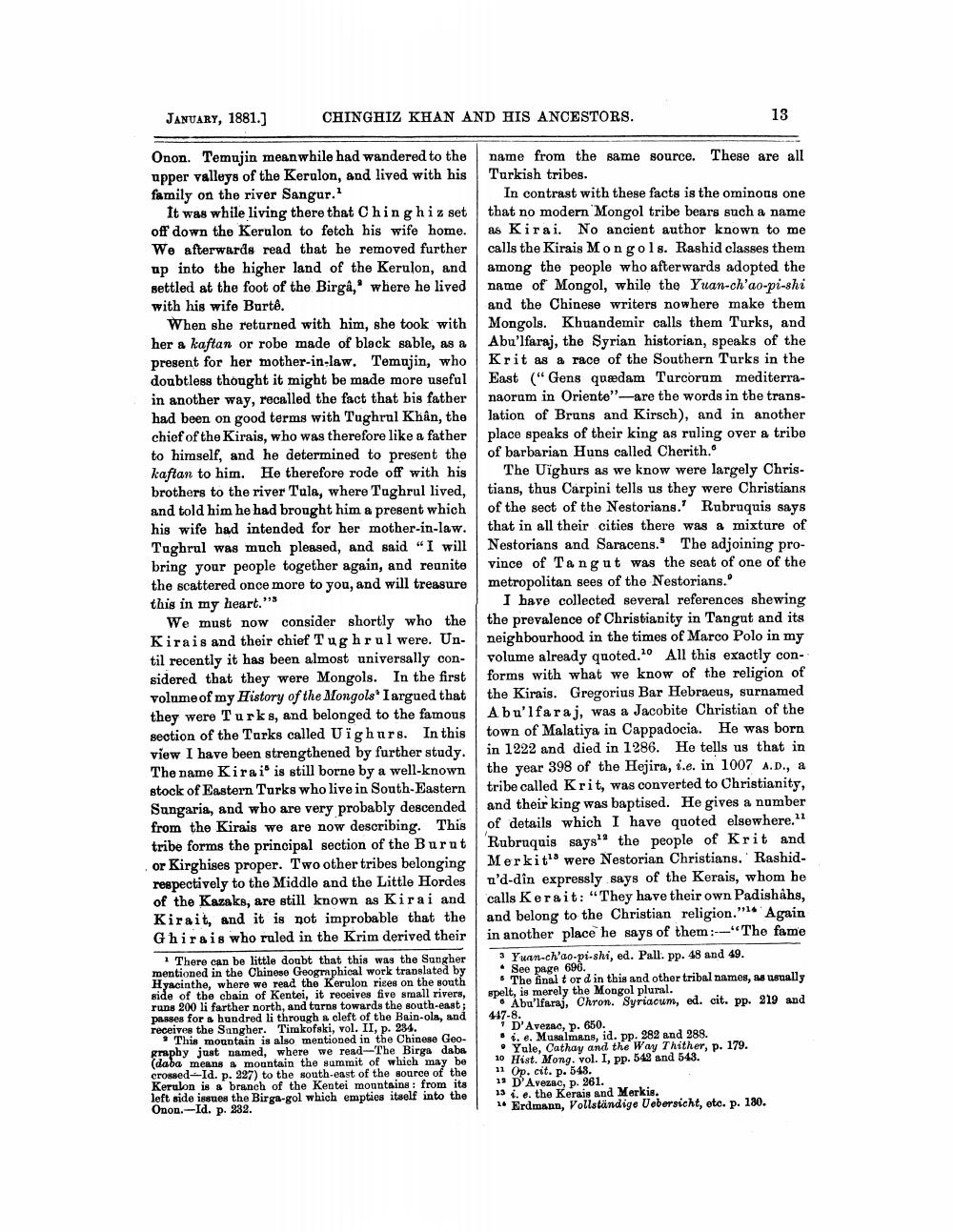________________
JANUARY, 1881.]
CHINGHIZ KHAN AND HIS ANCESTORS.
Onon. Temujin meanwhile had wandered to the upper valleys of the Kerulon, and lived with his family on the river Sangur.1
It was while living there that Chin ghiz set off down the Kerulon to fetch his wife home. We afterwards read that he removed further up into the higher land of the Kerulon, and settled at the foot of the Birgâ, where he lived with his wife Burtê.
When she returned with him, she took with her a kaftan or robe made of black sable, as a present for her mother-in-law. Temujin, who doubtless thought it might be made more useful in another way, recalled the fact that his father had been on good terms with Tughrul Khân, the chief of the Kirais, who was therefore like a father to himself, and he determined to present the kaftan to him. He therefore rode off with his brothers to the river Tula, where Tughrul lived, and told him he had brought him a present which his wife had intended for her mother-in-law. Tughrul was much pleased, and said "I will bring your people together again, and reunite the scattered once more to you, and will treasure this in my heart."""
We must now consider shortly who the Kirais and their chief Tug hrul were. Until recently it has been almost universally considered that they were Mongols. In the first volume of my History of the Mongols I argued that they were Turks, and belonged to the famous section of the Turks called Uighurs. In this view I have been strengthened by further study. The name Kira is is still borne by a well-known stock of Eastern Turks who live in South-Eastern Sungaria, and who are very probably descended from the Kirais we are now describing. This tribe forms the principal section of the Burut or Kirghises proper. Two other tribes belonging respectively to the Middle and the Little Hordes of the Kazaks, are still known as Kirai and Kirait, and it is not improbable that the Ghirais who ruled in the Krim derived their
There can be little doubt that this was the Sungher mentioned in the Chinese Geographical work translated by Hyacinthe, where we read the Kerulon rises on the south side of the chain of Kentei, it receives five small rivers, runs 200 li farther north, and turns towards the south-east; passes for a hundred li through a cleft of the Bain-ola, and receives the Sungher. Timkofski, vol. II, p. 234.
This mountain is also mentioned in the Chinese Geography just named, where we read-The Birga daba (daba means a mountain the summit of which may be crossed-Id. p. 227) to the south-east of the source of the Kerulon is a branch of the Kentei mountains: from its left side issues the Birga-gol which empties itself into the Onon.-Id. p. 232.
name from the same source. These are all Turkish tribes.
In contrast with these facts is the ominous one
that no modern Mongol tribe bears such a name as Kirai. No ancient author known to me calls the Kirais Mongols. Rashid classes them among the people who afterwards adopted the name of Mongol, while the Yuan-ch'ao-pi-shi and the Chinese writers nowhere make them Mongols. Khuandemir calls them Turks, and Abu'lfaraj, the Syrian historian, speaks of the Krit as a race of the Southern Turks in the East ("Gens quædam Turcorum mediterranaorum in Oriente"-are the words in the translation of Bruns and Kirsch), and in another place speaks of their king as ruling over a tribe of barbarian Huns called Cherith."
The Uighurs as we know were largely Christians, thus Carpini tells us they were Christians of the sect of the Nestorians.' Rubruquis says that in all their cities there was a mixture of Nestorians and Saracens. The adjoining province of Tang ut was the seat of one of the metropolitan sees of the Nestorians."
I have collected several references shewing the prevalence of Christianity in Tangut and its neighbourhood in the times of Marco Polo in my volume already quoted.20 All this exactly conforms with what we know of the religion of the Kirais. Gregorius Bar Hebraeus, surnamed Abu'lfaraj, was a Jacobite Christian of the town of Malatiya in Cappadocia. He was born in 1222 and died in 1286. He tells us that in the year 398 of the Hejira, i.e. in 1007 A.D., a tribe called Krit, was converted to Christianity, and their king was baptised. He gives a number of details which I have quoted elsewhere."1 Rubruquis says the people of Krit and Merkit's were Nestorian Christians. Rashidu'd-din expressly says of the Kerais, whom he calls Kerait: "They have their own Padishȧhs, and belong to the Christian religion." Again in another place he says of them:-"The fame
14
13
3 Yuan-ch'ao-pi-shi, ed. Pall. pp. 48 and 49. See page 696.
The final t or d in this and other tribal names, as usually spelt, is merely the Mongol plural.
Abu'lfaraj, Chron. Syriacum, ed. cit. pp. 219 and
447-8.
D'Avezac, p. 650.
i. e. Musalmans, id. pp. 282 and 288.
Yule, Cathay and the Way Thither, p. 179.
10 Hist. Mong. vol. I, pp. 542 and 543.
11 Op. cit. p. 548.
13 D'Avezac, p. 261.
13 i. e. the Kerais and Merkis.
1 Erdmann, Vollständige Uebersicht, etc. p. 180.




